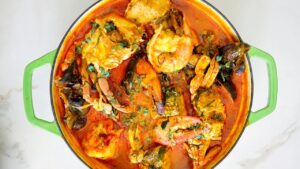Fisherman Peppered Soup is a cherished dish in Nigerian cuisine, particularly famous in the coastal regions where fresh seafood is abundant. Known for its bold flavors, aromatic spices, and nourishing ingredients, this soup is a favorite among seafood lovers. It is typically prepared with a variety of fresh fish and shellfish, combined with a rich blend of spices and herbs that create a warming, peppery broth. This comprehensive guide explores the origins, ingredients, preparation methods, cultural significance, and health benefits of Fisherman Peppered Soup.

Origins and Cultural Significance
Historical Background
Fisherman Peppered Soup has its roots in the riverine and coastal communities of Nigeria, where fishing is a primary livelihood. This dish reflects the local lifestyle and the availability of fresh seafood. It was traditionally prepared by fishermen using their daily catch, seasoned with locally sourced spices and herbs. Over time, the recipe has evolved but still retains its authentic essence and is a staple at communal gatherings and festive occasions.
Regional Variations
While Fisherman Peppered Soup is enjoyed across Nigeria, there are regional variations that highlight local tastes and ingredients:
- Niger Delta Region: Known for its abundance of fresh seafood, the soup here often includes prawns, crabs, and periwinkles alongside fish, creating a rich, flavorful broth.
- Lagos and Western Nigeria: In these urban areas, the soup might incorporate a variety of fish like catfish, tilapia, and even imported seafood, with a preference for spicier and more aromatic versions.
- Eastern Nigeria: The Igbo people often add unique local spices and herbs, such as uziza leaves and uda seeds, enhancing the soup’s depth of flavor.
Cultural Celebrations
Fisherman Peppered Soup is more than just a meal; it is a dish often served during celebrations and special occasions. It is a common feature at weddings, naming ceremonies, and festivals, where it symbolizes hospitality and the richness of Nigerian culinary tradition. Preparing the soup is often a communal activity, fostering social bonds and a sense of community.
Ingredients and Their Nutritional Benefits
Core Ingredients
- Fresh Fish: The primary ingredient, which can include catfish, tilapia, mackerel, or any fresh catch. Fish is an excellent source of high-quality protein, omega-3 fatty acids, and essential vitamins and minerals.
- Shellfish: Common additions are prawns, crabs, and periwinkles. These seafood options are rich in protein, omega-3 fatty acids, and various vitamins and minerals, contributing to overall health.
- Pepper and Spices: Scotch bonnet peppers, ground crayfish, and a blend of local spices like uziza seeds, uda seeds, and ehuru (calabash nutmeg) give the soup its distinctive heat and flavor.
- Herbs: Fresh herbs like uziza leaves, scent leaves, or basil add aromatic freshness and enhance the soup’s nutritional profile.
- Seasoning Cubes and Salt: Used to enhance the overall taste of the soup.
Optional Ingredients
- Vegetables: Adding vegetables such as okra or garden eggs can enhance the nutritional value and texture of the soup.
- Palm Oil: Some variations include a small amount of palm oil for added richness and color.
- Yam or Plantains: These can be cooked in the soup for added substance and to serve as a starchy side.
Preparation Methods
Traditional Preparation
- Preparing the Ingredients:
- Clean and cut the fish into desired pieces, ensuring to remove any scales and entrails.
- If using shellfish, clean them thoroughly.
- Grind the crayfish and set aside.
- Prepare the pepper mix by blending Scotch bonnet peppers with onions and other desired spices.
- Cooking the Soup Base:
- In a large pot, bring water to a boil and add the ground crayfish, pepper mix, and seasoning cubes.
- Add the cleaned shellfish first, as they take longer to cook. Allow them to simmer for a few minutes.
- Adding the Fish:
- Gently add the fish pieces to the pot, ensuring they are fully submerged in the broth.
- Add any additional spices and herbs, such as uziza seeds and leaves, uda seeds, and scent leaves.
- Simmering:
- Let the soup simmer on medium heat, allowing the flavors to meld together. Stir gently to avoid breaking the fish pieces.
- Taste and adjust seasoning with salt and additional spices as needed.
- Final Touches:
- If using vegetables like okra or garden eggs, add them towards the end of the cooking process to retain their texture and nutritional value.
- If including yam or plantains, they should be added early enough to cook through and absorb the flavors of the broth.
Modern Variations
- Pressure Cooker Method: Use a pressure cooker to speed up the cooking process, especially for tougher shellfish.
- Healthier Alternatives: For a lighter version, use less oil and incorporate more vegetables.
- Vegetarian Fisherman Soup: For a vegetarian version, omit the seafood and use mushrooms, tofu, and a variety of vegetables to create a flavorful broth.
Serving Suggestions
Fisherman Peppered Soup is traditionally served with a variety of Nigerian staples:
- Rice: White rice is a common accompaniment that balances the spicy soup.
- Yam: Boiled or pounded yam pairs well with the rich broth.
- Plantains: Boiled or fried plantains offer a sweet contrast to the spicy soup.
- Eba (Garri): Made from cassava flour, eba is a convenient and complementary side.
- Fufu: Another popular starchy side that absorbs the soup’s flavors beautifully.
Health Benefits of Fisherman Peppered Soup
Nutrient-Dense Ingredients
- Fish and Shellfish: Rich in high-quality protein, omega-3 fatty acids, and essential vitamins and minerals, these ingredients support heart health, brain function, and overall well-being.
- Pepper and Spices: The capsaicin in Scotch bonnet peppers boosts metabolism and has anti-inflammatory properties. Local spices also contribute antioxidants and other health benefits.
- Herbs: Fresh herbs like uziza and scent leaves provide vitamins, minerals, and antioxidants, supporting immune health and digestion.
Balanced Meal
Fisherman Peppered Soup, when paired with a starchy side like rice or yam, offers a balanced meal with carbohydrates, proteins, fats, and a variety of micronutrients.
Weight Management
The high protein content in the soup helps maintain satiety and can aid in weight management by reducing overall calorie intake.
Blood Sugar Control
The complex carbohydrates in sides like yam and fufu release glucose slowly, helping to maintain stable blood sugar levels, making Fisherman Peppered Soup a suitable option for individuals managing diabetes.
Tips for Making the Perfect Fisherman Peppered Soup
- Fresh Ingredients: Use the freshest seafood available to ensure the best flavor and nutritional value.
- Balanced Spicing: Adjust the level of pepper and spices to suit your taste, ensuring a balance that enhances rather than overwhelms the seafood.
- Gentle Cooking: Simmer the soup gently to prevent the fish from breaking apart and to allow the flavors to meld together.
- Consistent Stirring: Stir the soup occasionally to prevent sticking and ensure even cooking.
- Experiment with Additions: Feel free to experiment with different types of fish, shellfish, and vegetables to suit your taste preferences and nutritional needs.
Conclusion
Fisherman Peppered Soup is a quintessential Nigerian dish that embodies the rich culinary traditions and diversity of the country’s coastal regions. Its unique combination of fresh seafood, bold spices, and aromatic herbs creates a flavorful and nutritious meal that is beloved by many. Whether enjoyed with rice, yam, or any other staple, Fisherman Peppered Soup offers a satisfying and wholesome dining experience. By following traditional preparation methods and incorporating modern variations, you can enjoy this delicious soup while reaping its numerous health benefits. Embrace the flavors of Nigeria and add Fisherman Peppered Soup to your culinary repertoire for a taste of authentic Nigerian cuisine.










